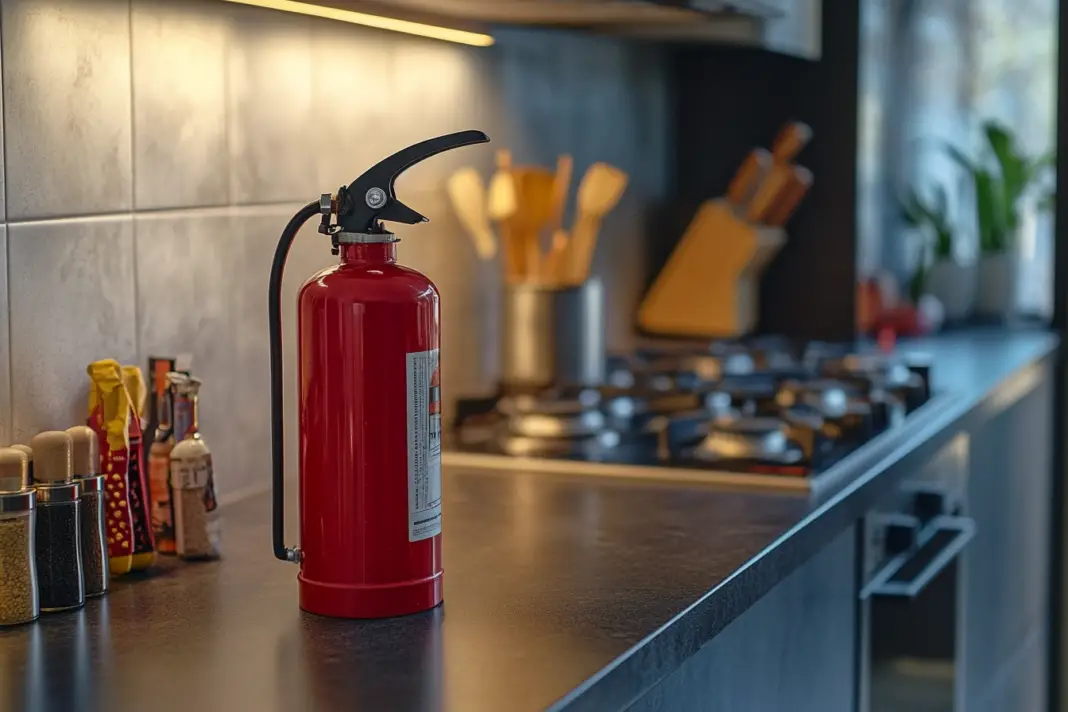When it comes to home fire safety, most people focus on smoke detectors and escape plans. However, there’s one critical aspect that’s often overlooked – the strategic placement of fire extinguishers. While having these life-saving devices is important, knowing exactly where to position them can mean the difference between a minor incident and a devastating house fire.
Why standard fire extinguisher placement fails
Many homeowners make the common mistake of placing their fire extinguishers in spots that seem logical at first glance, but could actually hinder their effectiveness during an emergency. The conventional wisdom of storing extinguishers in easily visible locations isn’t necessarily wrong, but it overlooks crucial factors that could impact your ability to respond quickly during a fire emergency.
According to fire safety experts, the most critical factor in fire extinguisher placement isn’t visibility – it’s accessibility along evacuation routes. This means positioning extinguishers where you’re most likely to pass by them while escaping, ensuring you can grab one without deviating from your escape path.
Studies have shown that during a fire emergency, people tend to follow familiar paths through their homes rather than taking the shortest route to safety. This behavioral pattern makes it essential to consider your household’s daily movement patterns when deciding where to place fire extinguishers, rather than just putting them in obvious but potentially impractical locations.
The effectiveness of a fire extinguisher isn’t just about having it within reach – it’s about having it within reach at the right moment. Fire safety professionals recommend maintaining a clear path to your extinguishers and ensuring they’re positioned no more than 30 feet from potential fire sources while still being along your natural exit route.
The optimal distance from fire hazard zones
A critical aspect of fire extinguisher placement that many homeowners overlook is the optimal distance from potential fire sources. While it might seem logical to place extinguishers right next to areas where fires are likely to start, this approach can actually make the extinguisher inaccessible when you need it most.
Safety guidelines recommend positioning fire extinguishers approximately 20-30 feet away from potential fire hazards. This distance provides a safe buffer zone while ensuring the extinguisher remains within quick reach during an emergency. The key is finding the sweet spot between accessibility and safety.
Consider the kitchen, where many house fires originate. Instead of mounting the extinguisher directly next to the stove, place it near the kitchen entrance. This positioning allows you to grab the extinguisher before entering a potentially dangerous situation, while still maintaining quick access to the fire source.
The same principle applies to other high-risk areas like garages, workshops, and heating equipment. Position extinguishers along the path leading to these spaces rather than directly beside potential fire sources. This strategic placement ensures you can access the extinguisher without putting yourself in harm’s way.
Height matters more than you think
The vertical placement of fire extinguishers is a crucial factor that often gets overlooked in home safety planning. While many people focus on where to position extinguishers horizontally throughout their home, the height at which they’re mounted can significantly impact their accessibility and effectiveness in an emergency situation.
Fire safety experts recommend mounting extinguishers so that their top is no more than 5 feet from the ground. This height requirement isn’t arbitrary – it’s based on ergonomic studies that show this placement provides optimal accessibility for most adults while still keeping the extinguisher out of reach of small children.
The bottom of the extinguisher should also be at least 4 inches off the ground. This elevation prevents moisture damage and corrosion that can occur when extinguishers are placed directly on the floor. Additionally, this height makes the extinguisher less likely to be blocked by other items that might get placed around it.
Consider mounting brackets that provide clear visibility and easy release mechanisms. These brackets should be sturdy enough to hold the extinguisher securely but designed for quick removal in emergencies. Some modern mounting systems include glow-in-the-dark features or reflective materials for better visibility in dark or smoky conditions.
Multi-level home placement strategies
Homes with multiple levels present unique challenges for fire extinguisher placement. Each floor requires its own strategic positioning to ensure maximum coverage and quick access during emergencies. The layout and use of each level should influence where you place these critical safety devices.
Safety experts emphasize the importance of having at least one fire extinguisher per floor, with additional units near high-risk areas. This distribution ensures that no matter where a fire starts, you won’t need to travel between floors to access an extinguisher.
For basements and upper floors, consider placing extinguishers near the stairs but not at the bottom or top step where they could become inaccessible. Position them slightly offset from the stairway, where they’re visible and accessible but won’t impede evacuation if the stairs become unusable during an emergency.
In split-level homes, treat each distinct living area as a separate floor requiring its own fire extinguisher. Pay special attention to areas with specific fire risks, such as laundry rooms, home offices with multiple electronics, or hobby spaces with heat-generating equipment.
Maintenance location considerations
The environment where you store your fire extinguisher can significantly impact its longevity and reliability. Temperature fluctuations, humidity, and exposure to various elements can affect the extinguisher’s performance when you need it most. Understanding these environmental factors is crucial for maintaining your fire safety equipment.
Regular inspections become even more critical for extinguishers placed in areas prone to temperature extremes or moisture exposure. Locations near windows, heating vents, or in uninsulated spaces require more frequent checks to ensure the equipment remains in working order.
Consider the impact of seasonal changes on your extinguisher’s location. Areas that might seem ideal during moderate weather could become problematic during summer heat waves or winter freezes. This is particularly important for extinguishers stored in garages, attics, or other spaces without climate control.
When choosing mounting locations, avoid areas where cleaning supplies, chemicals, or other corrosive materials are stored. These substances can potentially damage the extinguisher’s external components over time, compromising its reliability when needed.
Strategic placement for different fire types
Different areas of your home face different types of fire risks, and your fire extinguisher placement strategy should reflect these variations. Understanding the relationship between fire types and extinguisher classes helps ensure you have the right protection in the right places.
Fire safety guidelines recommend specific types of extinguishers for different areas. For instance, kitchens benefit from combination ABC extinguishers that can handle multiple fire types, while workshops might require additional coverage for electrical fires.
Consider the primary activities in each space when deciding on extinguisher placement. Areas where multiple types of fires could occur, such as kitchens with both cooking equipment and electrical appliances, might benefit from having two different types of extinguishers positioned strategically.
Pay special attention to seasonal changes in fire risk. Areas that might seem low-risk during cooler months could become higher-risk during heating season, requiring adjustments to your extinguisher placement strategy.
Visual marking systems that work
Creating an effective visual marking system for your fire extinguishers can significantly reduce response time during emergencies. While the extinguishers themselves might be visible, additional visual cues can help family members and visitors quickly locate them when seconds count.
Modern fire safety recommendations suggest using high-visibility signs or markers above extinguisher locations. These markers should be positioned above the extinguisher at eye level or higher, ensuring they remain visible even if furniture or other items are moved around.
Consider implementing a color-coding system for different types of extinguishers in your home. This can help family members quickly identify the appropriate extinguisher for specific types of fires, potentially saving crucial seconds during an emergency response.
Photoluminescent signs or strips can provide visibility during power outages or when smoke reduces visibility. These materials absorb and store light, making them effective guides to extinguisher locations even in low-light conditions.
Access points and obstacles to avoid
The path to your fire extinguisher should be as straightforward as possible, free from potential obstacles that could impede quick access during an emergency. Many well-intentioned placement decisions fail to account for common household obstacles that could become dangerous barriers in a crisis situation.
Experts recommend maintaining a clear space of at least three feet around each extinguisher. This clearance ensures that the equipment can be accessed quickly from multiple angles, regardless of how the emergency situation develops.
When selecting mounting locations, consider how seasonal changes might affect accessibility. Holiday decorations, temporary storage, or rearranged furniture shouldn’t interfere with extinguisher access. Regular checks of these clearance zones should become part of your routine home safety inspections.
Remember that emergencies often occur in less-than-ideal conditions. Smoke, darkness, or panic can make even minor obstacles significant barriers. Position extinguishers where they can be reached without requiring navigation around furniture, through doors, or past potential hazards.
Special considerations for mobility needs
Homes with residents who have mobility challenges require additional thought when it comes to fire extinguisher placement. Standard mounting heights and locations might not be suitable for everyone, and adaptations may be necessary to ensure all household members can access these crucial safety devices.
For wheelchair users, extinguishers should be mounted at a lower height, typically between 3 and 4 feet from the floor. This placement ensures the equipment remains within reach while still maintaining proper clearance from the ground.
Consider installing additional extinguishers in areas frequently used by individuals with mobility needs. This might mean having more units than typically recommended, but the extra coverage provides important redundancy for safety.
The type and weight of extinguishers should also be considered. Smaller, lighter units might be more manageable for some users, while still providing adequate fire protection. Multiple smaller units strategically placed might be more practical than fewer, larger ones.
Integration with home safety systems
Modern home safety systems can work in conjunction with strategically placed fire extinguishers to create a comprehensive fire protection strategy. The integration of various safety elements can enhance overall emergency preparedness and response capabilities.
Consider positioning fire extinguishers near smoke detectors and other safety equipment. This creates natural safety stations throughout your home, making it easier to remember where emergency equipment is located and ensuring multiple safety tools are readily available.
Some newer homes feature smart smoke detection systems that can indicate the location of a fire. Aligning fire extinguisher placement with these detection zones can help ensure the closest appropriate extinguisher is easily identifiable during an emergency.
Emergency lighting systems should be coordinated with extinguisher locations to ensure visibility during power outages. Consider installing battery-powered emergency lights near extinguisher locations to maintain accessibility in all conditions.
Proper fire extinguisher placement isn’t just about having these devices in your home – it’s about ensuring they’re positioned where they’ll be most effective when needed. By following these strategic placement guidelines and maintaining regular inspections, you’re not just checking a box for home safety – you’re maximizing your ability to respond effectively to a fire emergency. Remember, the goal isn’t just to have fire extinguishers, but to have them in the right places, ready to use when seconds count.

